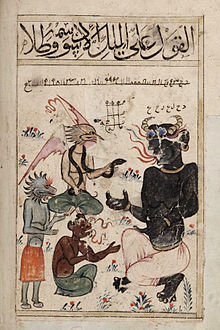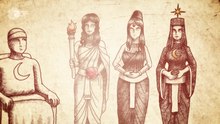Old Arabic religion
Old Arabic religion is a collective term for the ethnic beliefs of the Arabs and people on the Arabian Peninsula before the rise of Islam in the 7th century.
It is a polytheistic religion with a strong ancestor cult and belief in spiritual beings ( jinns ).
Sources
There are only a few written documents that provide information about the world before Islam, because an oral tradition was predominant on the Arabian Peninsula until the early days of Islam. The literacy of this culture was little or no pronounced. The most important original written source for the life and belief of the people still preserved today is the ancient Arabic poetry . Furthermore, inscriptions or coins give clues. Most of the information that is available today about this time comes from Islamic literature: The Koran , the Sunna and the biography of the founder of the religion, Mohammed, provide more or less detailed information about the beliefs of people in the Islamic world called the time of the Jāhiliyya . However, all types of text must be considered subject to a source-critical analysis.
history
The ancient Arabic religion is based on the polytheistic Sumerian and Babylonian religions . At first it gave way to the monotheism of the Jewish and Christian religion, especially in the south of the Arabian Peninsula (see the old South Arabian empire of Saba ). With the rise of Islam, the world of ideas then became increasingly less important on a broad level and was forgotten over time. First of all, people tried to counter the new beliefs that Mohammed , a man from among them, was spreading. The Qur'an reports several skirmishes between the followers of the Altarabic religion, called muschrikun in Islamic parlance , which means idol worshipers, and the Muslims. After ultimately devastating defeats against the followers of Islam, you ultimately had little choice but to accept Islam as your new faith or to flee.
Belief world
The followers of the ancient Arabic religion worshiped a multitude of ancient Arabic deities ; in addition, trees and stones and the dead were venerated. The most famous deities were the goddesses Al-Lāt , Manat and Uzza . It is not known how important the god Allah was .
Places of worship were mostly in the immediate vicinity of Mecca . At the center of the rite was the cult of the black stone in Mecca itself and a pilgrimage there; Both were later transferred to Islam by the Muslims from the ancient Arab religion as Kaaba and Hajj . The pilgrimage of the ancient Arabs is an important economic factor for the city of Mecca. The commandments of Islam on ritual purity ( tahara ) go back at least partially to corresponding commandments of the ancient Arabic religion.
Bedouins usually had special places, scattered all over the Arabian Peninsula, to worship gods. Ancestors were either worshiped at their graves or at special ceremonies in the distance.
literature
- Julius Wellhausen : Remains of Arab paganism. Walter de Gruyter, Berlin 1887.
- Maria Höfner : The pre-Islamic religions of Arabia . In: H. Gese, M. Höfner, K. Rudolph: The religions of Old Syria, Altarabia and the Mandaeans. Kohlhammer, Stuttgart a. a. 1970, pp. 233-402.
See also
Individual evidence
- ^ Robert G. Hoyland: Arabia and the Arabs: From the Bronze Age to the Coming of Islam . Routledge, 2002, ISBN 978-1-134-64634-0 ( google.com [accessed December 6, 2018]).
- ^ Robert G. Hoyland: Arabia and the Arabs: From the Bronze Age to the Coming of Islam . Routledge, 2002, ISBN 978-1-134-64634-0 ( google.com [accessed December 6, 2018]).
- ^ Charles Russell Coulter and Patricia Turner. Encyclopedia of Ancient Deities . Routledge. p. 37.
- ^ Robert G. Hoyland: Arabia and the Arabs: From the Bronze Age to the Coming of Islam . Routledge, 2002, ISBN 978-1-134-64634-0 ( google.com [accessed December 6, 2018]).

